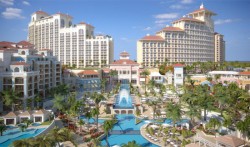While projects to redevelop and rejuvenate the tourism product are planned for Grand Bahama, they are not without some daunting challenges, according to David Johnson, deputy director of Tourism.
Speaking at the Grand Bahama Business Outlook conference on Tuesday, Mr. Johnson said Grand Bahama is operating with several challenges that hinder the island’s ability to compete effectively.
“We need to recognize that we are operating with several handicaps, one of which is our lack of critical mass and inability to achieve the much-needed economies of scale to compete effectively,” Mr. Johnson said.
“I don’t believe we should sit back and simply continue to rationalize our lack of achievement by articulating what is ailing us, but take swift measures to fix it.”
Mr. Johnson said one of the challenges Grand Bahama faces is it has one of the highest airport turnaround costs within the region that is hurting the tourism industry on the island.
“Unless Grand Bahama begins to offer competitive airport turnaround costs, we would be hard pressed to stay in business, much less pursue any growth strategies,” he said.
Mr. Johnson described the current dilemma for Grand Bahama’s tourism industry.
“When compared to Nassau, our cost is some $34 per person more,” Mr. Johnson said.
“What this means is that on a 50-seat aircraft with average loads of 75 percent, GBI costs $1,275 more to turnaround the Dash 8-500. On a jet with 125-seat capacity with a 75 percent load factor, GBI costs $3,187 more per turnaround or well over $1 million per year if they operated a daily service.”
Mr. Johnson said that in July 2005 Miami’s air traffic grew only by 2 percent from 1,389,298 persons to 1,423,313 persons. He said Fort Lauderdale grew by almost 200 percent for the same month from 319,849 to 953,120.
Mr. Johnson said a significant number of the Fort Lauderdale passengers are persons who live in Dade County, but choose to save money by using Fort Lauderdale for cheaper flights on Southwest, Jetblue, Spirit and AirTran, all of which avoid flying into high costs airports.
He said if Miami International did not have the European and South American long haul network it would be out of business. Mr. Johnson said the airport would be forced to drop its costs to at least Fort Lauderdale’s levels to regain its share of the pie.
He said this comparison shows Grand Bahama needs to find a way to compete, or it would be difficult to pursue or experience any significant growth.
“The customer really doesn’t care to know and will not research the reason for our high costs; it’s none of their business. They will simply choose other more attractive options as they view them,” Mr. Johnson said.
“Jetblue and Spirit refuse to operate flights to Miami for reasons related to cost and in the same way will not consider serving Grand Bahama Island for the same reason, in addition to several other considerations.”
Providing an update of the island’s tourism performance, Mr. Johnson said Grand Bahama Island enjoyed its best six consecutive months in performance in over 12 years in the first half of 2004 before being ravished by two consecutive hurricanes which resulted in the loss of one third of the island’s hotel room capacity, which remains today.
“Last fall, Hurricane Wilma caused minimal disruptions in the tourism sector, except for West End, but inflicted more damage in the residential coastal areas on the western sector than the two previous hurricanes,” Mr. Johnson said.
He said that at the end of 2005, the island finished with overall tourist arrivals being down by 11.2 percent. Air arrivals were down by 20 percent and sea arrivals were down 5.8 percent.
Mr. Johnson said that on a positive note, Grand Bahama rebounded in the last quarter of 2005 with air arrivals showing a 64 percent increase over the same period a year before and sea arrivals posting a 107 percent increase compared to 2004.
While there exists challenges in the area of air traffic arrivals to the island, Mr. Johnson said cruise tourism has remained consistent over the past 15 years.
He said this was accomplished despite a “far less than ideal” cruise port, and he assured that change is on the way.
“We are encouraging the development of a state-of-the-art new passenger cruise facility for Grand Bahama that would, after its completion, result in cruise arrivals swiftly reaching the 1.5 million mark from the existing 400,000 we are achieving today.
“A new cruise port will inject approximately $100 million per annum in tourist expenditures in this island’s economy,” Mr. Johnson projected.
Listing further planned expansions and redevelopment, Mr. Johnson said there will be a complete recovery in tourism arrivals by the winter of 2007, and a new cruise port driving cruise tourism levels comparable to that of New Providence within four years.
Mr. Johnson said the Ministry of Tourism will embark on a period of new construction and rapid growth, which will add to the tourism product on Grand Bahama. This, he said, will begin by late summer 2006 and continue for the next 10 years.
The tourism official also forecasted that Grand Bahama will reach the 4,000-room capacity by winter 2007 and see it doubled by 2016.
“Grand Bahama will attract a growing share of Bahamians who will move to this island because of the superior economic opportunities and overall quality of life it can offer,” Mr. Johnson predicted.
“This will lead to the accomplishment of our goal of creating greater economies and efficiencies and assist in making Grand Bahama the world class destination it can be.”
By: Daphne McIntosh, The Bahama Journal



